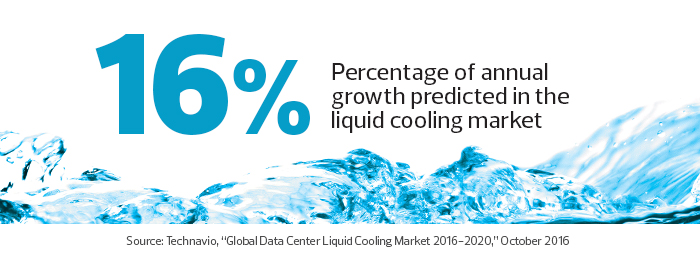Liquid Cooling Can Transform High-Density State and Local Government Data Centers
After investing in high-density technology and the high-performance computing required to power smart city initiatives, state and local leaders are considering the most reliable — and efficient — methods to cool their data centers.
Enter liquid cooling. Liquid cooling has gained traction largely because traditional cooling doesn’t go far enough to support high-performance computing, says Todd Boucher, founder of Leading Edge Design Group.
Liquid cooling falls into two broad categories: immersion cooling, in which IT equipment is fully submerged in a dielectric liquid, and direct CPU cooling, in which a cold plate is placed directly on the heat source (CPU).
In the latter, cool water (or liquid) circulates over the plate to keep the CPU operating within targeted temperature specifications.
For traditional data centers, direct CPU cooling is the more prevalent of the two options, Boucher says. It offers a number of benefits, especially at very high density. Placing the heat neutralization (cold plate) directly on the heat source is a much more efficient means of rejecting the heat from IT equipment when compared with air-based systems.

At high density, the direct CPU cooling setup yields substantial energy savings.
Increased deployment of artificial intelligence and Internet of Things technology make that flexibility critical to delivering IT services at scale.
SIGN UP: Get more news from the StateTech newsletter in your inbox every two weeks!
Liquid Cooling Should Be Added with Care
Fujitsu has several decades of experience in liquid cooling for mainframes. HPE and Dell introduced liquid cooling to certain server products in 2016.
Other vendors are following suit, but liquid cooling cannot simply be added to existing servers.
And unless a new data center is being built in a new building, where plumbing might be more easily added to server racks along with other liquid cooling–specific construction, it’s an expensive proposition.
“Taking risks goes against the grain for the typical data center manager, and for good reason. Their job is to protect very critical assets — data and expensive infrastructure,” says Jennifer Cooke, research director for the data center trends and strategies team at IDC.
That was the case in Canfield, Ohio, where officials briefly considered whether to adopt liquid cooling when moving the city government’s data center from a small closet to a dedicated room in 2016.
Dominic Rozzo, network and systems administrator, says his team found that liquid cooling would be too expensive, would come with too much downtime and would be too great of a risk. Canfield’s data center is being cooled by the existing air-conditioning unit, but a Mitsubishi mini-split system will be installed in the next year.
Officials in New York City have also considered liquid cooling, but determined the system was unnecessary, spokeswoman Kate Blumm says. The city’s data centers average 6 kilowatts to 8kW per cabinet, where water cooling could handle upward of 20kW.
While the technology may not be a top priority for state and local IT officials today, it’s slowly making its way to a data center near you.








